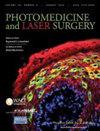Effects of Photobiomodulation and Ultrasound Applications on Orthodontically Induced Inflammatory Root Resorption; Transcriptional Alterations in OPG, RANKL, Cox-2: An Experimental Study in Rats.
Q2 Medicine
引用次数: 7
Abstract
Objective: The aim of this study was to evaluate and compare the reparative and inhibitory effects of a light-emitting diode-mediated photobiomodulation (PBM) and of a low-intensity pulsed ultrasound (LIPUS) on orthodontically induced inflammatory root resorption (OIIRR). Materials and methods: Forty-nine Wistar rats were divided into four groups: untreated group (negative control), group treated with orthodontic appliances (positive control), PBM-treated group (wavelength: 618 nm, output power density: 20 mW/cm2), and LIPUS-treated group (frequency: 1.5% ± 5% MHz, pulse repetition ratio: 1.0% ± 10% kHz, effect area: 3.88% ± 1% cm2 and intensity: 30% ± 30% mW/cm2). OIIRR was induced experimentally in rats for 14 days with an applied force of 100g, and therapeutic approaches were performed concurrently. At the end of the experiment, upper first molar teeth of rats were prepared for genetic analysis, scanning electron microscopy, hematoxylin and eosin staining, and tartrate-resistant acid phosphatase staining. Kruskal-Wallis and post hoc Dunn's tests were performed. Results: Number of osteoclasts (p < 0.01), number of resorption lacunae and resorption area ratio (p < 0.001) decreased and number of total cells (p < 0.001) increased with the PBM and LIPUS applications when compared with the positive control group. Receptor activator of nuclear factor kappa B ligand (RANKL) levels of PBM and LIPUS groups were lower (p < 0.001), and osteoprotegerin (OPG) levels were higher (p < 0.001) than the positive control group. Cyclooxygenase-2 (Cox-2) expression significantly decreased with LIPUS and PBM administrations (p < 0.05). No significant difference was observed among PBM and LIPUS groups. Conclusions: PBM and LIPUS applications showed marked inhibitory and reparative effects on OIIRR by modulating the OPG/RANKL ratio, Cox-2 expression, and cell differentiation of osteoblasts and osteoclasts.光生物调节和超声对正畸诱导炎症根吸收的影响大鼠OPG, RANKL, Cox-2转录改变的实验研究
目的:本研究的目的是评估和比较发光二极管介导的光生物调制(PBM)和低强度脉冲超声(LIPUS)对正畸诱导的炎症性牙根吸收(OIIRR)的修复和抑制作用。材料与方法:49只Wistar大鼠分为4组:未治疗组(阴性对照)、正畸矫治器治疗组(阳性对照)、PBM治疗组(波长:618 nm,输出功率密度:20 mW/cm2)和LIPUS治疗组(频率:1.5% ± 5%MHz,脉冲重复率:1.0% ± 10%kHz,影响面积:3.88% ± 1%cm2,强度:30% ± 30%mW/cm2)。用100g的作用力在大鼠体内实验诱导OIIRR 14天,同时进行治疗。实验结束时,制备大鼠上第一磨牙进行基因分析、扫描电子显微镜、苏木精和伊红染色以及抗酒石酸酸性磷酸酶染色。进行了Kruskal Wallis和事后Dunn的测试。结果:破骨细胞数量(p < 0.01)、吸收陷窝数和吸收面积比(p < 0.001)减少,总细胞数(p < 0.001)随PBM和LIPUS应用而增加。PBM和LIPUS组的核因子κB配体受体激活因子(RANKL)水平较低(p < 0.001)和骨保护素(OPG)水平较高(p < 0.001)。环氧合酶-2(Cox-2)的表达随着LIPUS和PBM的给药而显著降低(p < 0.05)。PBM组和LIPUS组之间没有观察到显著差异。结论:PBM和LIPUS应用通过调节OPG/RANKL比率、Cox-2表达以及成骨细胞和破骨细胞的细胞分化,对OIIRR表现出显著的抑制和修复作用。
本文章由计算机程序翻译,如有差异,请以英文原文为准。
求助全文
约1分钟内获得全文
求助全文
来源期刊
CiteScore
4.50
自引率
0.00%
发文量
0
审稿时长
6-12 weeks
期刊介绍:
Photobiomodulation, Photomedicine, and Laser Surgery (formerly Photomedicine and Laser Surgery) is the essential journal for cutting-edge advances and research in phototherapy, low-level laser therapy (LLLT), and laser medicine and surgery. The Journal delivers basic and clinical findings and procedures to improve the knowledge and application of these techniques in medicine.

 求助内容:
求助内容: 应助结果提醒方式:
应助结果提醒方式:


